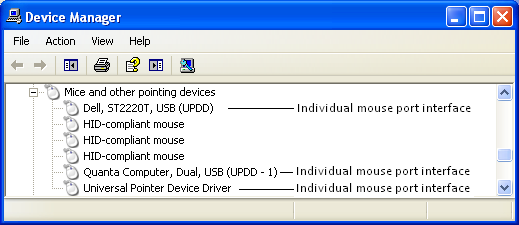|
|
|||||||||||||||||||||||||||
|
Windows: |
|
|
|||||||||||||||||||||||||
|
Linux: |
|
|
|
|
|||||||||||||||||||||||
OverviewThe standard user configuration for mainstream desktop operating systems is one user, one cursor, irrespective of the number of input devices connected to the system (monitors, touch screens, mice, keyboards etc).
However, in recent years it has been possible to configure systems to be multi-user, multi-cursor and this document describes the multi-user configurations that have been tested with UPDD and shows the software utilised and the settings required. WindowsThere are a number of products that allow for shared resources on a single base unit so that a system can be used by multiple users. To cater for this functionality the multi user software has to support multiple keyboards, multiple monitors and multiple pointer devices, such as mice and touch screens, whereby the hardware items can be allocated to individual users. This allows each user to have a dedicated keyboard, monitor and mouse. If the monitor is a touch screen monitor then the touch device also needs to be allocated to a specific user such that it controls the pointer (cursor) on the monitor allocated to that user.
These types of systems have been predominantly aimed at school / class room usage but can also be used in other environments. ConfigurationThese products, by in large, rely on each touch device being registered as a mouse or HID device in the device manager such that the device can be allocated to a given user.
The UPDD touch driver registers both a default HID (Vista onwards) and Mouse instance through which to pass touch co-ordinate information to the Windows OS. These are seen in the device manager as follows:
The usage of these interfaces is dictated by the UPDD Extended Touch setting associated with each touch device. If enabled, touch data is fed to the OS via the HID interface, if disabled the Mouse interface is used.
Thereafter, for each UPDD PnP touch device connected to a system the driver creates additional “mouse instances” in the device manager. The design of the driver is such that non PnP serial devices do not create a mouse instance.
Prior to UPDD version 5 all cursor movement and click requests for all connected ‘Mice’ touch devices were (for internal technical reasons) passed through the default mouse instance, as shown below:
Unfortunately, this does not work well with multi user layers as they need touch data to pass through the individual HID or mouse entry associated to each touch device.
To cater for this requirement we have modified UPDD version 5.x to work in this way
In the first implementation of this we have only catered for the use of multiple mouse instances, not HID. For a future release we will be investigating if it is possible to implement a Virtual HID entry for each touch device.
UPDD touch priority setting When UPDD is handling multiple touch devices in a singe user environment it manages the way the touches from the individual devices are passed to the mouse port interface in such a way that touches from each device cannot be interspersed. This prevents more than one touch device being used at the same time, such that the cursor would jump between the touch devices. In a multi-user environment this management is not required as the multi-user software is managing the input from each device. The UPDD management of the individual touch devices should be disabled in a multi-user environment by setting the touch priority for each device to Disable. This setting can be updated using the UPDD Command line utility as shown below:
Multi user productsThe table below indicates some of the multi user products and shows the UPDD release tested and working or the current status of development if not working:
We believe that, in theory, with the change made in UPDD 5.0.2 most multi user type products should work so long as they support absolute touch data being delivered via the mouse interface. LimitationsGiven that UPDD driver does not currently create a separate mouse instance for non PnP serial devices these cannot be used in multi-user type systems. Further changes to UPDD would be required to support these devices in multi-user environments.
If using these products in Vista or Windows 7 (they seem to be predominantly XP based) then the UPDD Extended Touch setting for each device must be disabled so that the touch data is passed thro the individual mouse instances, not the single HID interface. This restriction may be removed in a future release of the driver when multiple HID entries are utilized. LinuxUnder Linux the X multi seat configuration option can be utilised as described here. To utilise UPDD in a multi seat configuration refer to the Linux multi-screen documentation here. ContactFor further information or technical assistance please email the technical support team at technical@touch-base.com.
|
|||||||||||||||||||||||||||
